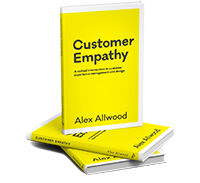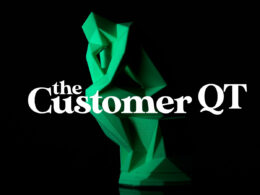Editor’s Note: We talk a lot about understanding and engaging our customers but we really don’t talk a lot about the softer skills required to relate to our customers. Ideas like respect and honor aren’t often mentioned in campaign briefs or in marketing circles at large. And yet, it is those same soft skills that enable real engagement. Near the top of that critical but oft-ignored soft-skill list sits the notion of customer empathy.
In this extract from Alex Allwood’s new book Customer Empathy: A radical intervention in customer experience management and design, she explores why empathy with customers is declining, despite the growing focus on customer experience management.
I will never forget the day when United Airlines passenger, Dr. David Dao, was knocked unconscious and forcibly dragged off his flight. Like millions of others, I watched in disbelief as a customer who had paid for his ticket was hauled out of the plane for refusing to give up his seat on the overbooked flight.
His violent removal past rows and rows of distressed passengers was captured by fellow passengers on their mobile phones—one video was “shared over 87,000 times and viewed 6.8 million times” in less than 24 hours.
It took United’s CEO, Oscar Munoz, three tries before his public apology statements showed any empathy. Munoz’s first statement of apology was appallingly low on concern: “I apologise for having to re-accommodate these customers.”
Again, social media went into meltdown. In his second statement, Munoz compounded his error by blaming the victim, describing him as, “defiant, belligerent and disruptive.”
Only on his third attempt, when Munoz said, “I promise you we will do better” did he demonstrate any empathy for customers, employees and a horrified public.
In the weeks that followed the Dr. Dao disaster, there were successive incidents on United flights. In one, a flight attendant insisted a passenger’s pet dog travel in the overhead luggage compartment, and despite assurances that the dog would be fine, the customer’s pet was found dead upon arrival.
United’s empathy deficit reflected a poor company culture and poor leadership. Allowed to thrive, this poor conduct flourished; it proliferated and was rewarded. Even with a mandate from Munoz to empower employee decision making, to ‘put customers first’, the airline’s relentless focus on efficiency and operationalisation of policies was so entrenched, that employee capacity for empathic concern was suppressed.
Losing customer connection
Organisations face a seemingly insurmountable challenge in transitioning to a customer-centric culture. Executives and employees alike have lost their human connection with customers. They have lost a propensity to understand customers—to perspective-take, to step into their customers’ world and experience their lives from the customer’s point of view; to understand how their customers think, feel and experience.
Instead, employees are bound to their work through technology, data, scores and business outcomes. Organisations too, are structured to deliver greater productivity and efficiency, increasing internal competition and decreasing collaboration and communication. In consequence, businesses’ thinking, problem solving and decision making have become less and less human. Without customer empathy, how do we bring organisational understanding and meaning to what’s important to customers in designing and delivering experiences?
Author of Wired to Care, Dev Patnaik, describes corporations as like a building; bringing people together, protecting them from the world and providing them an environment in which to work effectively. “When you’re inside a building with central heating and cooling, the temperature is perfectly tuned to be pleasant … it also cuts you off from clues about the weather outside.”
As a metaphor this aptly describes the status quo in many organisations— employees are starved of customer perspective, which leads to customer understanding deprivation and a lack of empathetic concern.
Many leaders see empathy as a soft skill and ‘fluffy’. To their detriment, organisations haven’t considered customer empathy as a commercial tool or as an employee skill; one that can be switched on, developed and strengthened.
Empathy and power
United Airlines’ Oscar Munoz has admitted the airline’s relentless focus on efficiency created a toxic culture that forced employees to prioritise efficiency over their care for customers. “We let rules and procedures get in the way of our people.”
This had resulted in customers experiencing poor employee behaviour, poor leadership decision making, an ongoing lack of judgement, rudeness, and a perception of incompetence. Munoz’s leadership had prioritised business gain at any cost.
Research shows that personal power interferes with a business leader’s ability to empathise. Dacher Keltner, social psychologist at the University of California, Berkeley, has conducted studies showing “that people who have power suffer deficits in empathy, the ability to read emotions, and the ability to adapt behaviors to other people.”
Rosemary Sainty, UTS Business School academic and founding Australian representative to the UN Global Compact, believes there is a systemic lack of leadership empathy with customers. Sainty argues directors have little understanding of customer needs. “They don’t know them. How can they act in their best interests?”
Richard Boyatzis, professor at Weatherhead School of Management, Case Western Reserve University, argues that “lack of empathic concern in organisations results in multiple disasters, including losing touch with the hearts and minds of your staff, your customers, your suppliers and community.”
Empathy lost in silos
Organisations are plagued with silos; operational silos, channel silos, system silos and data silos—large businesses need silos or specialist departments or teams to get work done. Organisational structures use functional silos in an effort to reduce complexity and promote efficiency and productivity; decreasing costs and increasing output to maximise shareholder returns—mostly at the expense of customer experience.
Organisational silos reflect an employee’s specialist classification and expertise, and there’s little reason to disrupt the functional group they’ve been assigned to. The reality is, the employee siloed mindset is entrenched in most organisations. Evidence of the siloed mindset is seen in a ‘them versus us’ attitude, job demarcation, or situations where employee teams are crippled; stifling productivity, blocking coordination of resources and effort and negatively impacting the delivery of customer experiences.
Departmental silos have their own goals, incentives and agendas. They often have a limited customer view and a limited understanding of, or interest in, customers.
Customer empathy gets lost in functional silos; suffocated by a culture of unsympathetic behaviours, where employees lose touch with customers’ needs in the grind of day-to-day competitive business pressures.
Instead, their primary focus is product/service-centric or serving internal stakeholders. Silos perpetuate a culture of competitiveness, defensiveness and tribal discord, resulting in inward-looking departments and blinkered decision making.
For CX efforts, the siloed mindset impacts customer collaboration; stifling a unified and coordinated approach on customer experience effort. Turf wars commonly perpetuate the hoarding of information in silos; information impacting the availability of critical data and insights for problem solving and decision making. Silos create bureaucracy, are the death of effective CX management practice and the cause of customer infuriation.
Customer empathy gets lost in functional silos; suffocated by a culture of unsympathetic behaviours, where employees lose touch with customers’ needs in the grind of day-to-day competitive business pressures. As the author of The Silo Effect Gillian Tett argues, “when our classification systems become excessively rigid, and silos dangerously entrenched, this can leave us blind to risks and exciting opportunities.”
Empathy’s number is up
Organisations have an unhealthy data obsession. The volume, velocity, and variety of data is overwhelming, to the point where customers are, more often than not, expressed as a number; a satisfaction score, a data point, sale, account number, revenue or profitability metric etc.
Our fixation with data, metrics and more recently, performance-related customer scores, is stifling empathetic concern for customers.
Customer satisfaction metrics, such as Customer Satisfaction scores (CSat), Net Promotor Scores (NPS) and Customer Effort Scores (CES), were intended to rally employees to improve customer experiences. Instead, an obsession with score chasing is having the opposite effect. While some organisations use customer experience metrics well, many more are choosing to focus efforts on measurement over systemic change to improve end-to-end experiences.
A recent article in The Wall Street Journal on score obsession argued, “Management consultants are notorious for pushing ideas to CEOs using jargon and claims of improved business performance. NPS has outlived such fads, spawning a cottage industry of consultants and software firms that help businesses implement and boost their score.”
Instead of employee focus on improving customer experiences, reward and incentivisation for score improvement is driving effort towards attaining a good score result—a score ‘lift’. In the worst cases I’ve seen, employees are biasing surveys by selectively targeting customers who will give a good score, priming surveys with specific language and even pressuring customers for higher ratings.
Fred Reichheld, the inventor of NPS, said he is “astonished companies are using NPS to determine bonuses and as a performance indicator. That’s completely bogus. I had no idea how people would mess with the score to bend it, to make it serve their selfish objectives.”
Reinforcing this view, motivational researcher Carol Dweck and behavioural economist Dan Ariely have observed, “Employees end up spending a lot of energy on improving a score, and it’s never a great customer experience when somebody begs you for a 10. More importantly, score-obsessed employees are highly likely to become cynical and lose the sense of pride in their work, which is a sure way to destroy any chance of becoming a customer-centric organisation.”
Layer upon layer, organisations are building systems with the aim of delivering business performance at the expense of improving customer wellbeing. Systems that keep customers at arm’s length and promote employee behaviours that develop empathetic detachment, individualism, ego and self interest. Data now represents customers that are out of view, who are seen as scores rather than human beings, disconnecting employees from the purpose of their work—to make a difference in customers’ lives.
 This is an abridged extract from Customer Empathy: A radical intervention in customer experience management and design. In the book, two-time author and leading authority on customer experience, Alex Allwood asks why, with so many organisations investing vast amounts of energy and effort into customer experience excellence, is there at best, only incremental gain. Alex outlines her customer-centric framework, methods and tools to switch on and scale customer empathy that can be used to solve the common customer experience management problems of low organisational commitment, poor alignment of cross-functional teams, and competing agendas and priorities. Customer empathy helps leaders and employees to see the customer’s world differently. Doubling down on CX practices by switching on customer empathy to create deeper understanding, more meaningful connection, align and unite teams and enrich decision making to benefit customers, employees and the business.
This is an abridged extract from Customer Empathy: A radical intervention in customer experience management and design. In the book, two-time author and leading authority on customer experience, Alex Allwood asks why, with so many organisations investing vast amounts of energy and effort into customer experience excellence, is there at best, only incremental gain. Alex outlines her customer-centric framework, methods and tools to switch on and scale customer empathy that can be used to solve the common customer experience management problems of low organisational commitment, poor alignment of cross-functional teams, and competing agendas and priorities. Customer empathy helps leaders and employees to see the customer’s world differently. Doubling down on CX practices by switching on customer empathy to create deeper understanding, more meaningful connection, align and unite teams and enrich decision making to benefit customers, employees and the business.
Buy the book from https://customerempathy.com/
This article first appeared in MyCustomer. Photo by Annie Spratt on Unsplash.












